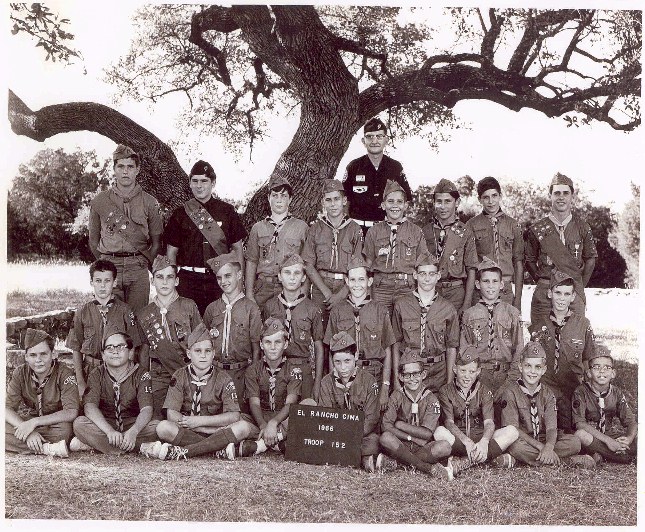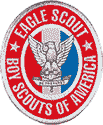Troop 152
Go On Adventure and Build Character
Sam Houston Area Council
Mustang District SHAC page
Mustang District Leaders
Mustang District Facebook
OA Coloneh Lodge
OA Mustang Chapter
St Jerome Catholic Church
Catholic Committee on Scouting
Medical Form Parts A & B
(Weekend Camps and Activities)
Medical Form Parts A, B, & C
(Summer and Winter Camp)
Uniform Insignia Guide
Uniform Exchange
Scholarships
Guide to Safe Scouting
Youth Protection Training
Virtus / Safe Haven
Troop 152 History

Troop 152 is rich in history and background. Countless young men have begun their scouting careers with Troop 152, and a select few have reached the ultimate in scouting as Eagle Scouts. This history is written as a tribute to all leaders and scouts who have at any time proudly worn the numbers 152 on their uniform.
Our history begins when Troop 152 was initially chartered in 1937. A piece of our history is present with us at all times in our scout house. We are fortunate to have preserved our initial charter dates 12-10-37 for St. Joseph’s Church on Kane St. near downtown Houston. At the time of the initial chartering, the Pastor of St. Joseph’s Church was Father J.D. Connally. All scout meetings were held on Friday evenings at St. Joseph’s Church. The first Scoutmaster was Karl Curry and Assistant Scoutmaster was Joseph Ciulla; Francis Haberger and Ceasar Jamail were assistants. There were about 11 boys in those early days and among them was the late Mgr. William Tinney, who served as Pastor of several parishes, including the founding pastor of St. John Vianney Catholic Church in west Houston area.
There were many special activities and events highlighting the first 20 years of the troop. One of the earlier memorable and more notable events in the minds of many members of the troop was when the troop was asked to participate as ushers or participants for the Howard Hughes parade, in honor of Howard Hughes after Mr. Hughes had flown the famous Spruce Goose airplane. A picture of the event was made and later featured on a calendar.
By 1940, the troop had grown to 18 members and many of the members maintained contact with other members as the years went by. Several members have been very instrumental in providing much useful information as to the history and background of scouting in those early years. Mr. Joe Sony has been particularly active, as well as Mr. Pete Knapick, who is a current member of St. Jerome Catholic Church. At the time Father Diefenbach, an assistant pastor, was chairman of the troop committee, troop meetings continued on Friday evening at the church. In 1941 after the original Scoutmaster had been drafted into the service, Jeffery Krystinik became the second Scoutmaster of the troop. Membership during the war years consisted of many younger boys as many of the older boys had been drafted. In 1942 F. J. Haberger became Scoutmaster, the same man who had registered as an assistant when the troop began. The ages of the boys in the troop were between 12 and 15. There are no records of Eagle Scouts during those earlier years, because the requirements for Eagle were more difficult than those in modern scouting, and many of the scouts were drafted after their 15th birthday and thus did not have the opportunity to reach the rank of Eagle.
Father Diefenback entered the military service and became well known for his efforts in returning a sacred relic of St. Stephen from Austria to Hungary. After Father Diefenbach entered the service, Father George Rabroker, who currently resides in Beaumont, became the pastoral representative and chaplain to the troop. Under Father Rabroker a group of about 15 early scouts and leaders began the practice of “staying in touch” and have continued that practice up to the present day.
In the early years, camping was done primarily at Camp Hudson, a Boy Scout camp located on the bayou and the flat land west of Houston. Camping supplies for campouts were trucked from St. Joseph’s Church to the campsite in Hercules Dynamite Trucks, which were loaned to the troop. It was customary for the scouts to hike to camp, a distance of about 14 miles from the church. Camp Hudson was located near the present day intersection of Memorial Drive and Gessner.
In these early years the troop received much acclaim for its work in the civilian effort during the war. The troop had one of the first and possibly the only Emergency Service Corp to provide home assistance for the years when the war was at its peak. The troop was recognized for its efforts during the war in recycling and similar endeavors, and for its efforts on the farms in “Spring”, which is believed to be the present Spring Branch area.
Father Diefenbach was always interested in flying and acquiring a pilot’s license and after much effort he qualified for flying lessons even though his eyesight was less than normal. In order to address this shortcoming Father attempted to remedy his eyesight problem by consuming vast quantities of carrots to improve his vision. Father’s efforts were successful and he earned his coveted pilot’s license and permit. Tragically many years later Father Diefenbach was killed in a civilian airplane crash in Houston.
In the late 1940’s the troop had an average of 20 members. In 1949 Mr. Curry returned to the troop after the war as committee chairman. In 1951 Mr. James Lombard became Scoutmaster. Explorer scouting began at St. Joseph’s in 1951. In the period from 1952 to the early 1960’s troop information is sketchy. While the Charter was never forfeited or returned, records reflect little activity. and the number of young men active in the troop is unknown. In February 1961 the Charter of Troop 152 was formally transferred and activated at the then very new St. Jerome Catholic Church in the rapidly growing west Houston area. The charter transfer ceremony was held at Landrum Junior High School. At the time of the transfer, Father Ludac was the Boy Scout Chaplain and conducted the ceremony. At this transfer ceremony the troop was presented with an American flag by the Veterans of Foreign Wars. Mr. Karl Curry, who was pointed out was the initial Scoutmaster, again assumed the role of Scoutmaster at the time of the transfer.
There are many stories that can be told about the activities of the troop which are memorable and worthy of note. It is hoped that with the ease of communications through such means as the Internet, that our history can be expanded with many interesting stories and thoughts about the scouting events of the past. The leaders of our troop have accomplished much in scouting, and their efforts are a legend as well. In the early and mid 1970’s our troop was blessed with many talented and caring leaders who had not been previously active in scouting simply because they were female, and in that period there was little personal involvement by mothers and other ladies. However one of the more active leaders was Shirley Burynski, who served in numerous capacities with Troop 152, the Sam Houston Area Council, and the Catholic Committee on Scouting. She worked on various activities in the district, which was then called the Tejas District. As a result of her activities, many interested ladies obtained Boy Scout council approval and attended the Wood Badge training program and formed the Foxy Ladies Patrol. This patrol set the standard for the involvement of many capable and talented ladies in scouting programs.
A history of Troop 152 would not be complete without recounting some of the many accomplishments of Hugo Bixio, who was the sixth (or was it seventh?) Scoutmaster of Troop 152. Mr. Bixio promoted virtually every part of the scouting program so that the youth who participated could benefit. During the years Mr. Bixio was Scoutmaster, camping and outdoor skills were emphasized in numerous campouts and trips, and many young men were taught the vital skills necessary to earn the rank of Eagle. One accomplishment that will never be forgotten was the paper drives held for several years, which resulted in the money being raised to build a scout house for the troop. The present scout house was opened in the mid 1980’s, which offered a facility to the troop that is virtually unparalleled. Bishop Markowsky attended the opening and blessed the building as a monument to the effort that was invested by all those participating in the efforts to collect papers to build the scout house. Even today the scout house carries the name of the “Hugo Bixio Memorial Scout House” as a fitting tribute to someone who advanced the scouting program in many ways and to someone who had boundless energy to help young men and to foster the concepts of the Boy Scout Law.

Newest Eagle Scouts:
Christian Rodriguez
William Sebesta

Bishop's Trophy:
Pack 152 - 2009/2010/2011
Troop 152 - 2008/2010/2013/2019
Crew 152 - 2009/2010/2011/2012/2013

Pope Paul VI Unit Award:
1994/1997/1998/1999/2000/2002
2003/2004/2005/2006/2007/2008
2009/2010/2011/2012/2013/2014
2015/2017/2018/2019